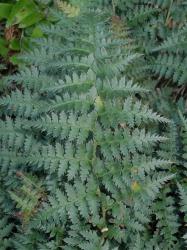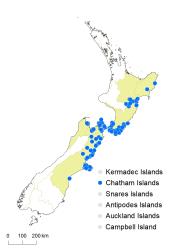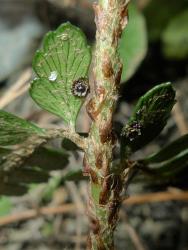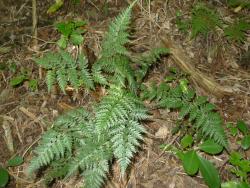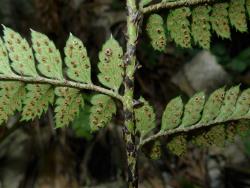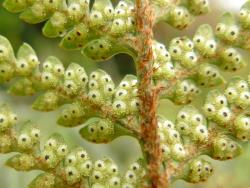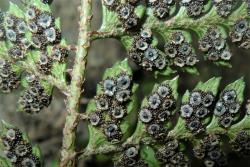- ≡ Aspidium oculatum Hook., Sp. Fil. 4, 24, t. 228 (1862)
- ≡ Dryopteris oculata (Hook.) Kuntze, Revis. Gen. Pl. 2, 813 (1891)
- ≡ Polystichum richardii var. oculatum (Hook.) C.Chr., Index Filic. 85, 280 (1905)
Rhizomes erect, densely scaly. Rhizome scales ovate, 9–19 mm long, 1–5 mm wide, bicolorous with dark centres and pale margins, margins toothed. Fronds 125–780 mm long. Stipes 55–500 mm long, yellow-brown, moderately to sparsely scaly throughout; scales at very base similar to those of rhizome; those at mid-stipe narrowly ovate to ovate, blackish-brown or irregularly bicolorous, apices acuminate, margins ciliate, bases sparsely fimbriate; those from the stipe/rachis junction 770–2280 μm wide at mid-length. Rachises yellow-brown, sulcate, narrowly winged only at distal end, scaly. Laminae 2-pinnate or rarely 3-pinnate proximally, ovate or elliptic, 75–410 mm long, 26–200 mm wide, blue-green adaxially, paler green abaxially, coriaceous, bearing abundant pale brown scales on abaxial costae and lamina surfaces, sparsely scaly on adaxial costae, ± glabrous on adaxial lamina surface. Primary pinnae in 8–24 pairs below pinnatifid apex, slightly overlapping distally, narrowly ovate; the longest at or near the middle, 15–115 mm long, 6–50 mm wide, apices acuminate, bases stalked; costae narrowly winged throughout. Secondary pinnae decreasing gradually in length along the primary pinna to the distal end; the longest secondary pinnae ovate, 4–32 mm long, 2–17 mm wide, apices sharply pointed, margins sharply and often deeply serrate, bases adnate or stalked. A few tertiary segments sometimes present on proximal pinnae, ovate, up to 12 mm long and 5 mm wide. Sori round, medial or nearer margin than costa; indusia round, 0.7–1.4 mm diameter, with conspicuous dark central area (5–50% of surface area). Mean spore size 36–48 μm long, 27–36 μm wide.
Polystichum oculatum is distinguished by the scales at the stipe/rachis junction, which are broad, blackish-brown or irregularly bicolorous, ciliate on the margins and sparsely fimbriate at their bases (Perrie et al. 2003, fig. 5). The indusia have a conspicuous black centre (ibid., fig. 6). The laminae are blue-green on the adaxial surfaces and paler green abaxially. It is likely to confused only with P. neozelandicum, which has narrower scales (135–570 μm wide, cf. 770–2280 μm wide), and larger spores (46–58 μm long, 36–45 μm wide, cf. 36–48 μm long, 27–36 μm wide). Further, while the primary costae and lamina are concolorous on the adaxial surface in P. oculatum, the primary costae are usually darker in P. neozelandicum (concolorous exceptions being mostly confined to Otago).
Polystichum oculatum is distinguished from most of the naturalised species by its lack of bulbils, from P. vestitum and P. sylvaticum by its usually concolorous rather than bicolorous scales at the stipe/rachis junction, from P. cystostegia by its flat rather than inflated indusia, and from P. wawranum by its much broader scales and indusia with dark centres.
North Island: Volcanic Plateau, Gisborne, Southern North Island.
South Island: Western Nelson, Sounds-Nelson, Marlborough, Canterbury.
Chatham Islands.
Altitudinal range: 0–900 m.
Polystichum oculatum occurs in coastal, lowland and montane areas of the eastern North Island from East Cape and the Hawke’s Bay ranges to Wairarapa and the Cook Strait region. It grows from sea level up to 740 m in the Kāweka Range. It is found in coastal, lowland and montane regions of the eastern South Island from Cook Strait to Timaru, ranging from sea level, up to 900 m at Jordan Stream Reserve, Marlborough. It also occurs on the Chatham Islands.
Polystichum oculatum occurs in drier coastal, broadleaved, podocarp and beech forest, under mānuka and kānuka, in pine plantations, on forest margins, and in grassland. It grows on coastal cliffs, hillsides, roadside banks, in rocky gullies, among boulders, on scree, and on river banks. It is found on greywacke, basalt, limestone and marble substrates.
There is evidence that Polystichum oculatum hybridises with P. neozelandicum and P. vestitum (Perrie et al. 2003).
n = 82 (Brownlie 1958 – as Polystichum richardii; Perrie et al. 2003).



